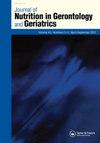Motivators, Barriers and Other Factors Related to Bean Consumption in Older Adults
Q3 Medicine
Journal of Nutrition in Gerontology and Geriatrics
Pub Date : 2019-07-30
DOI:10.1080/21551197.2019.1646690
引用次数: 21
Abstract
Abstract Beans are nutrient-dense and can reduce risk of chronic diseases. This is relevant to older adults who can benefit from consuming beans to reduce their elevated chronic disease risk. This study explored bean consumption in older adults (≥65 years) using mixed-methods including a researcher-administered questionnaire (n = 250) and focus groups (n = 49). Prevalence of bean consumption (daily or weekly) was 51.2%. Motivators to bean consumption were significantly more likely among bean consumers with the top three including nutritional value, taste/texture and versatility, which were also predictors of consuming beans (OR = 3.54, 2.72, and 4.24, respectively). Conversely, barriers to bean consumption were significantly more likely among bean non-consumers with the top three including not part of traditional diet/do not think to include beans in meals, flatulence/abdominal discomfort and lack of knowledge about preparation/cooking, which were also predictors of not consuming beans (OR = 3.85, 2.26, and 5.08, respectively). This research will inform dietary strategies to increase bean consumption.老年人食用豆类的动机、障碍和其他因素
豆类营养丰富,可以降低慢性疾病的风险。这与老年人有关,他们可以从食用豆类中获益,以降低慢性疾病的风险。本研究采用混合方法,包括研究人员管理的问卷调查(n = 250)和焦点小组(n = 49),探讨老年人(≥65岁)的豆类消费情况。每天或每周食用豆类的患病率为51.2%。在豆类消费者中,营养价值、味道/质地和多功能性这三大因素更有可能促使他们消费豆类(OR分别为3.54、2.72和4.24)。相反,不食用豆类的人更有可能出现食用豆类的障碍,前三名包括不属于传统饮食/不认为在膳食中加入豆类,胀气/腹部不适以及缺乏准备/烹饪知识,这些也是不食用豆类的预测因素(OR分别= 3.85,2.26和5.08)。这项研究将为增加豆类消费的饮食策略提供信息。
本文章由计算机程序翻译,如有差异,请以英文原文为准。
求助全文
约1分钟内获得全文
求助全文
来源期刊

Journal of Nutrition in Gerontology and Geriatrics
Nursing-Nutrition and Dietetics
CiteScore
2.20
自引率
0.00%
发文量
13
期刊介绍:
The Journal of Nutrition in Gerontology and Geriatrics publishes original research studies that are directly relevant to clinical and community nutrition issues that affect older adults. Epidemiologic and community-based studies are suitable for JNE, as are well-controlled clinical trials of preventive and therapeutic nutritional interventions. The Journal of Nutrition in Gerontology and Geriatrics invites papers on a broad array of topics in the nutrition and aging field, including but not limited to studies of: preventive nutrition, nutritional interventions for chronic disease, aging effects on nutritional requirements, nutritional status and dietary intake behaviors, nutritional frailty and functional status, usefulness of supplements, programmatic interventions, transitions in care and long term care, and community nutrition issues.
 求助内容:
求助内容: 应助结果提醒方式:
应助结果提醒方式:


